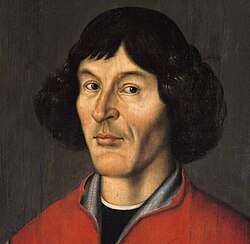General Astronomy/The Heliocentric Model
The modern heliocentric model of the universe was proposed by Nicolaus Copernicus in his book De revolutionibus orbium coelestium which was published just before his death to avoid prosecution for heresy. It addressed many of the problems associated with the Ptolemaic model which required a multitude of epicycles to describe planetary motion. Heliocentrism places the Sun at the center of the solar system. While some of the ancient civilizations in India and the Middle East had proposed the heliocentric model before, Copernicus' discovery set the groundwork for the modern view of the solar system.
Copernicus' Model
[edit | edit source]
In Copernicus' heliocentric model, there are seven theories he presents:
- There exists more than one center of the universe.
- There is a center of the universe near the sun.
- The planet Earth is not the center of our universe.
- The scale of distances between the Earth and the Sun is minuscule compared with the astronomical distances between Earth and the stars in the sky.
- The Earth revolves around the sun, thus causing the annual cycles of the seasons that we witness.
- The Earth's own rotation causes the stars to appear to shift every night, rather than any motion of the stars themselves.
- Any retrograde motion, previously explained by epicycles, is in fact caused by the differing orbital velocities of planets around the sun.
Copernicus harbored his belief of heliocentrism for many years, and did not publish his work until 1542, a year before he died. Some speculate that Copernicus held onto his idea for a considerable time simply because he was fearful of the reception it would have among his peers and more importantly, the Church. Many consider the publication of De revolutionibus orbium coelestium (On the Revolution of the Celestial Sphere) to be the start of the Scientific Revolution.
In the years that followed, Copernicus' theory was refined and independently verified by notable scientists, most prominently Galileo and Kepler. Specifically, Galileo noted that all phases of Venus occurred (similar to our moon), which cannot be adequately explained in a geocentric model. This contradicted the solely new and crescent phases predicted by the geocentric model.
